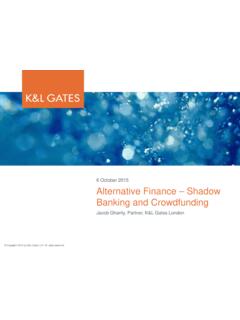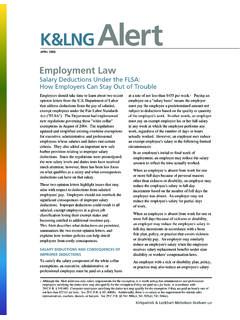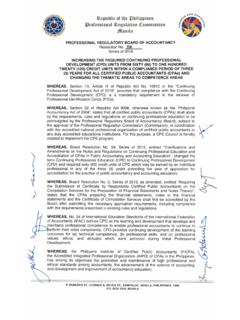Transcription of Conducting Internal Investigations - K&L Gates
1 Conducting Internal InvestigationsMichael J. MissalStavroula E. LambrakopoulosCurtis S. KowalkK&L Gates LLPW ashington, Internal Investigations2 INTRODUCTION ..3 DECIDING WHETHER TO INITIATE AN Internal investigation ..4 Statutory and Regulatory Obligation to Investigate ..4 Extent of Misconduct and Potential Violations ..5 Responding to Regulatory or Enforcement Inquiries ..6 BENEFITS AND PITFALLS OF AN Internal investigation ..7 Internal Investigations as a Form of Cooperation ..7 Identifying Remedial Steps and Preventing Future Misconduct.
2 8 The Risks of investigation ..8 THE investigation PROCESS ..9 Establishing the Identity of the Client and the Scope of the investigation ..9 Preventing Common Pitfalls ..9 Preservation of Evidence and Records ..9 Preserving Privileges ..9 Staffing the investigation ..12 Retaining Outside Counsel ..12 Establishing Reporting Lines of Authority and Supervision ..12 Gathering Evidence and Conducting Interviews of Witnesses ..13 Obtaining, Managing, and Analyzing Documents .. investigation S AFTERMATH ..17 Reporting the Findings of the investigation .
3 17 Advantages and Disadvantages of a Written the Report ..18 Disclosure of the Report ..20 Required Disclosure ..20 Voluntary Disclosure ..21 Disciplining Employees ..24 Discipline for Failing to Cooperate with the investigation ..24 Discipline for Underlying Conduct Uncovered During an investigation ..25 TABLE OF CONTENTSC onducting Internal Investigations3In the wake of recent corporate scandals, the financial crisis and the enactment of tougher corporate accountability standards under the Sarbanes-Oxley Act of 2002 ( SOX )1 and the Dodd-Frank Act,2 Internal Investigations have become an important exercise of good corporate governance.
4 Internal Investigations can be initiated for a variety of reasons, including allegations of significant corporate misconduct that could violate federal or state law, a complaint from an employee, ethical lapses or wrongdoings by a , under certain circumstances, an Internal investigation may be required by law or corporate policy or, at a minimum, strongly warranted to assist the corporation in staving off regulatory action, limiting significant civil monetary penalties, or avoiding suspension and bar orders. A thorough and credible Internal investigation may help determine, and often improve, the course of regulatory and criminal Investigations , as well as shareholder and third-party litigation.
5 Conversely, a poorly conducted investigation can place a corporation, and its directors and officers, in a worse position than they would have been in the absence of such an Investigations may take many forms, depending upon the nature of the conduct at issue and the scope of the investigation . If the suspected misconduct is limited and discrete, an Internal investigation may be conducted by the corporation s in-house counsel, compliance department INTRODUCTIONI nternal Investigations may take many forms, depending upon the nature of the conduct at issue and the scope of the investigation .
6 Or its Internal audit department. However, if the suspected misconduct is significant, or involves senior management or the board of directors, it likely should be conducted by outside counsel. While every Internal investigation has unique characteristics, to be most effective they should be timely, thorough, accurate, fair, objective and credible. If an Internal investigation does not meet all of these goals, it likely will be ineffective. Credibility is key, and as the seriousness of the conduct at issue increases, so should the independence of counsel Conducting the investigation .
7 This article discusses some of the considerations that are important to the decision whether to conduct an Internal investigation , the benefits and pitfalls of such Investigations , and the techniques for properly steering the course and conduct of the Pub. L. No. 107-204, 116 Stat. 745 (2002).2 Pub. L. No. 111-203 (2010). Conducting Internal Investigations4In deciding whether to conduct an Internal investigation , a company should take into consideration a number of factors including: (a) whether such an investigation is required by any law, regulation or corporate policy; (b) the scope and severity of the alleged misconduct and potential violations of law and regulation; (c) potential or actual interest or litigation by civil regulators, criminal authorities, and third parties.
8 And (d) the benefits and risks to the corporation and/or its officers, directors and employees of such an investigation . Depending on the nature of the misconduct at issue, an Internal investigation can consume tremendous resources, at great cost to the company, and potentially expose the company and its officers to greater liability by setting forth a blueprint for regulatory and private actions. The cost of inaction to a company, however, could swiftly outweigh any expense and litigation risk associated with a properly con-ducted investigation .
9 Failure to complete the investigation in a credible, timely and thorough manner could also be viewed as an attempt to cover-up the same token, a company s basis for Conducting an investigation will determine the manner in which the investi-gation is conducted, and how the results of the investigation will be reported and addressed. Internal Investigations can be used as a means for identifying and remedying miscon-duct within a company, as well as a defensive mechanism for addressing regulatory and prosecutorial Investigations and private WHETHER TO INITIATE AN Internal INVESTIGATIONA decision whether to initiate an Internal investigation is sometimes extremely difficult to make and may require significant analysis.
10 It is an important decision as once the decision to initiate an Internal investigation is made, it likely cannot be reversed. Conversely, great harm can result if a regulator believes that an Internal investigation should have been done and the decision was made not to conduct AND REGULATORY OBLIGATION TO INVESTIGATEThe use of Internal Investigations as a defensive mechanism has its roots in the SEC s voluntary disclosure program of the 1970s, which arose in response to widespread allega-tions of corruption and bribery, and led to the enactment of the Foreign Corrupt Practices Act of 1977 ( FCPA ).














